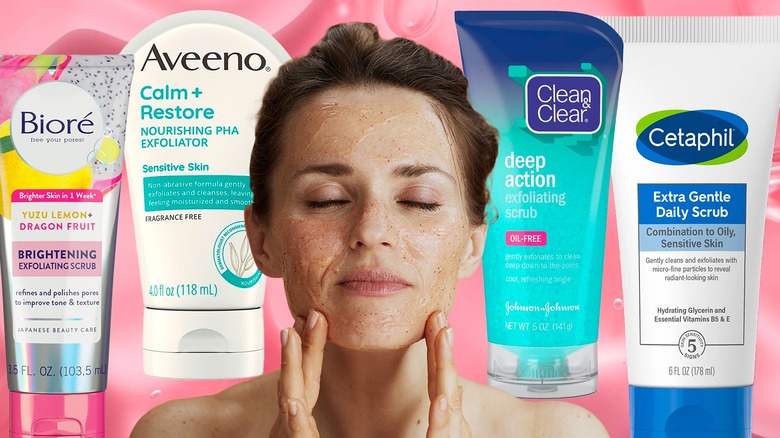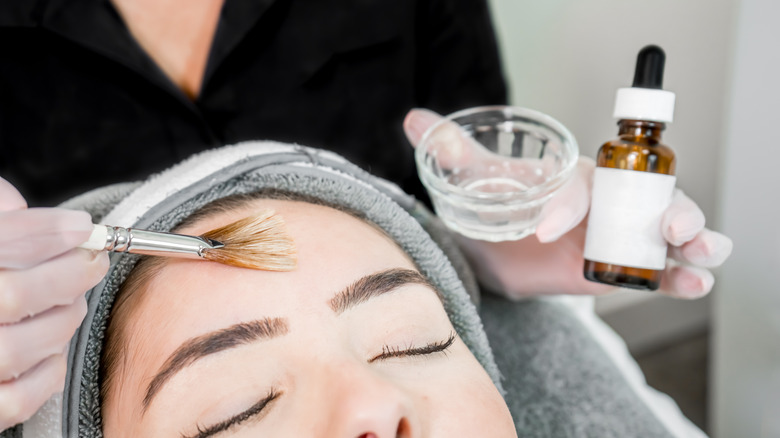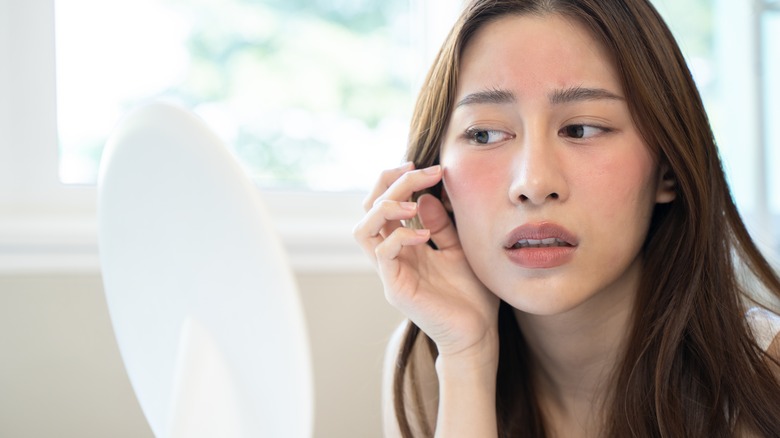Don't Use Multiple Exfoliating Products At Once - Your Skin Will Thank You
Skincare products require a lot of trial and error to achieve clear, smooth skin. Even if you find products that work for your skin, using them correctly is crucial to avoid damaging your skin barrier. One popular skincare regimen many dermatologists recommend is exfoliating, but folks don't always know how to do it.
"We all know that exfoliation is an important part of a skin-care routine," board-certified dermatologist Dr. Hadley King told Well+Good. "It's what helps to slough off dead skin cells and makes the skin look particularly glowy and fresh. It helps with discolorations and clogged pores, so it's doing all good things. The downside of exfoliation can be that it can be irritating and for different skin types."
Most folks will use multiple exfoliants in their skincare routine in hopes of helping enhance their skin faster, but they end up doing more damage. Exfoliating is ideal for removing dead skin cells, and there are two types: physical and chemical exfoliants, according to the American Academy of Dermatology Association. Chemical exfoliant products include alpha and beta hydroxy acids that you apply to the skin to dissolve dead skin cells. Physical exfoliants include dry brushing or scrubs to remove dead skin cells. You can use chemical and physical exfoliants simultaneously since they work to target the same issues but on different body parts.
All exfoliators are not the same
Using multiple exfoliating products at once can irritate the skin, especially if you're starting to use an exfoliant for the first time. You want to find products that will help improve your skin's overall texture and appearance. "There are no hard-and-fast rules like you can't mix an enzyme with a hydroxy acid, or you can't mix an alpha with a beta because it's all about the formulation and how your skin is tolerating it," Dr. Hadley King told Well+Good. If you have sensitive skin, limiting the number of exfoliators you use is vital to prevent damaging your skin barrier.
Exfoliation products can have various ingredients, such as alpha hydroxy acids (AHA's), beta hydroxy acid (BHA), retinoic acid, and enzymatic exfoliation, which help drive cell turnover and remove dead skin cells, as per procedural dermatologist, Dr. Davin Lim. However, these ingredients are often used separately in skincare products unless formulated together in a way that won't irritate your skin.
Since exfoliators have different ingredients, they will target specific skin issues. For example, if you have acne and oily skin, it's best to use salicylic acid as it will help penetrate deep into the glands. On the other hand, lactic acid is excellent for hydrating dry skin. That said, figuring out your prime skin issue will help you decide which exfoliant to use.
How often to exfoliate depends on your skin type
As mentioned, everyone has a different skin type, so not every product will work the same. Therefore, figuring out your skin type is essential. You'll know which ingredients will help improve your skin and how often you should exfoliate. However, there are many factors to consider that can affect your skin. Folks with sensitive skin, for example, should exfoliate once a week to see if they can tolerate the product, then increase to twice a week, according to Kim Gallo Esthetics. As for dry skin, exfoliating once a week is best to prevent drying out your skin more, and using gentle exfoliators is better than harsh chemicals. Oily and combination skin types can exfoliate around three times a week. However, pay attention to how your skin reacts to the ingredients. If you notice redness, irritation, or dryness, reduce the number of times you use it or use a different product. Lastly, normal skin types have more wiggle room and can exfoliate two to three times a week.
Keep in mind that how many times you exfoliate can also depend on your environment. Nevertheless, when using exfoliants — especially chemical types — always read the directions to prevent over-exfoliating, and don't forget to apply sunscreen afterward.


